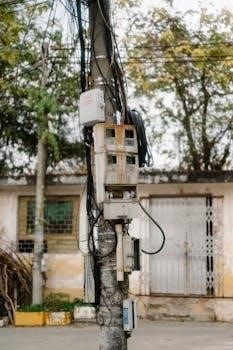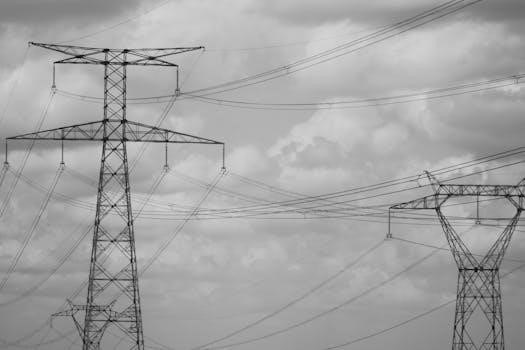A transformer wiring diagram is a visual representation of electrical connections. This guide provides a clear path for installing, maintaining, and troubleshooting the transformer. It serves as a visual aid, showing the internal framework and placement of accessories. Master transformer wiring with this step-by-step guide!
Understanding Transformer Basics
Transformers play a crucial role in electrical distribution systems, efficiently transferring electrical power. Utilities distribute electricity over large areas using high voltages, commonly called transmission voltages, typically in the 35,000 to 50,000 volt range. Transformers are essential due to the high cost of transmitting at lower voltage levels.
The voltage change in a transformer is determined by the ratio of turns of wire around the core between the primary and secondary windings. At a minimum a dual primary or secondary is needed to set the transformer up in series or parallel.
Transformers are the heart of AC power transmission and distribution, enabling efficient voltage adjustments. A transformer is a static device that transfers electrical energy from one circuit to another through electromagnetic induction. The core components include windings, core and insulation. Different transformer connections include star and delta configurations for various applications.
Reading Transformer Wiring Diagrams
A transformer wiring diagram is a visual representation of the electrical connections within a transformer, aiding in installation, maintenance, and troubleshooting. It serves as a visual guide that assists in comprehending how the transformers internal framework has been set up and where its accessories are generally positioned.
With regards to a power transformer diagram, there are two windings. These two main wires frequently appear in schematics as connections. The four main components that make up a distribution transformer diagram are the source connection, outlet link, cables or wires, and its core. The drawings show details of the transformer, switchgear, components, labeling and interconnections.
This guide offers a step-by-step visual walkthrough for reading diagrams, allowing users to interpret nameplates, windings, cooling systems, and manufacturer drawings. Pay special attention to the manufacturer’s guidelines for proper connections. A complete visual guide helps in deciphering transformer diagrams, schematics, and connections.
Necessary Tools and Safety Precautions
Wiring a transformer is a critical step that requires careful consideration of various factors to ensure the safe and efficient transfer of electrical power. Before initiating any work, it’s essential to gather the necessary tools. These typically include the transformer itself, wire strippers, a screwdriver, and a multimeter for testing voltage. Protective gear, such as gloves and safety goggles, is also a must to prevent injuries.
Safety is paramount when working with electrical components. Always disable the mains power supply by using lockout/tagout procedures before starting any wiring task. Ensure that all connections are secure to prevent loose wires or accidental disconnections.
Follow the manufacturer’s guidelines and wiring diagrams for proper connections. The object of this guide, based to a large extent on the findings and conclusions contained in a report by the AIEE Relay Committee titled Grounding of Instrument Transformer Secondary Circuits, emphasizes the importance of safety measures. Correct transformer installation is essential for overall safety.
Single-Phase Transformer Wiring

Single-phase transformers, like other electrical devices, may be connected in series or parallel arrangements. To help customers understand proper connections for dual primary and/or dual secondary transformers, we have prepared examples on a hypothetical dual primary & dual secondary setup. When wiring a transformer, it is important to understand the basics and be familiar with the components used in the process.
Firstly, put the transformer in place carefully. Then, disable the mains power supply using lockout/tagout procedures. Next, remove the panel covering the wires. Follow the manufacturer’s wiring diagrams for correct connections.
The voltage change is determined by the ratio of turns of wire around the core between the primary and secondary windings. Correctly wiring single-phase transformers is crucial for safe and efficient operation. Ensure all steps are followed precisely to avoid potential hazards and ensure optimal performance of the electrical system. The wiring process requires meticulous attention to detail.
Three-Phase Transformer Connections (Delta and Star)

A simple explanation of transformer connections involves understanding three-phase connections like delta-delta, star-star, delta-star, and star-delta. Three-phase transformers connect their primary and secondary windings in star or delta configurations for various electrical applications. It is important to understand the different configurations. With a transformer, you have to have at least a dual primary or a dual secondary (or both) if you want to set the transformer up in series or parallel;
Learn step-by-step how to configure a transformer in series or parallel connections. Understand the science behind the setup. The four main components that make up a distribution transformer diagram are the source connection, outlet link, cables or wires, and its core.
Understanding the different wiring configurations ensures proper installation and operation. Follow the manufacturers guidelines for proper connections. Secure the connections to prevent any loose wires or accidental disconnections. Correct wiring of the transformer is essential for safety and optimal performance. Ensure all connections are tight and properly insulated to prevent any electrical hazards.
Dual Primary and Dual Secondary Transformer Wiring
To help customers understand proper connections for dual primary and/or dual secondary transformers, consider several examples on a hypothetical dual primary & dual secondary transformer. With a transformer, you have to have at least a dual primary or a dual secondary, if you want to set the transformer up in series or parallel.
Single-phase transformers, like other electrical devices, may be connected into series or parallel arrangements. Learn step-by-step how to configure a transformer in series or parallel connections. Understand the science behind the setup. The four main components that make up a distribution transformer diagram are the source connection, outlet link, cables or wires, and its core.
Understanding the different wiring configurations ensures proper installation and operation. Follow the manufacturer’s guidelines and wiring diagrams for proper connections. Secure the connections to prevent any loose wires or accidental disconnections. Correct wiring of the transformer is essential for safety and optimal performance. Ensure all connections are tight and properly insulated to prevent electrical hazards.
Current Transformer Installation
ENSURE ALL CURRENT TRANSFORMERS ARE INSTALLED AS PER WIRING DIAGRAM. Installing current transformers involves several key considerations. The correct polarity must be observed when connecting the transformer to ensure accurate measurements. The installation direction is crucial for proper operation. The terminals S1/S2 (k/l) must be correctly identified and connected.

Cable length and cross-section are important factors to consider for minimizing power consumption. A quick overview of power consumption for Cu cables is helpful. ELEQ current transformers can be supplied for use at line voltage of up to 1200V. Follow the manufacturer’s guidelines and wiring diagrams for proper connections.
Secure the connections to prevent any loose wires or accidental disconnections. Correct current transformer installation is essential for accurate current measurement and the overall safety of the system. The requisite test voltage is 6 kV. Flexible installation modes include fixable on primary wire or bottom board. They are suitable for multi-form of primary wires, such as flat-type wires.

Troubleshooting Common Wiring Issues
When troubleshooting transformer wiring, several common issues may arise. One frequent problem is loose connections, which can lead to intermittent operation or complete failure. Always ensure that all connections are secure and properly tightened, following the manufacturer’s wiring diagrams. Incorrect wiring is another common issue, where wires are connected to the wrong terminals.
This can result in improper voltage output or even damage to the transformer or connected equipment. Carefully review the wiring diagram to verify that all connections are correct. Overheating is also a potential problem, often caused by overloading the transformer or inadequate ventilation.
Check the transformer’s nameplate for its rated capacity and ensure that it is not being exceeded. Additionally, ensure that the transformer has adequate airflow to dissipate heat. Another issue is insulation breakdown, which can lead to short circuits or ground faults. Inspect the wiring for any signs of damage or deterioration, and replace any compromised wires.
Finally, voltage imbalances can occur in three-phase systems. Use a multimeter to check the voltage on each phase and identify any discrepancies. Correct these imbalances by adjusting the transformer taps or addressing any issues with the incoming power supply.
Transformer Nameplate Interpretation
A transformer nameplate provides essential information about the unit’s capabilities and operational parameters. Understanding this information is crucial for professionals, technicians, and users. The nameplate typically includes the manufacturer’s name, model number, and serial number for identification and traceability. The kVA (kilovolt-amperes) rating indicates the transformer’s apparent power capacity, while the voltage ratings specify the primary and secondary voltages.
Frequency, usually 50 or 60 Hz, indicates the operating frequency. Impedance (%) is a key parameter for calculating fault currents. Insulation class specifies the temperature rating of the insulation materials. Vector group indicates the phase shift between primary and secondary windings in three-phase transformers. The connection diagram shows the internal winding connections, such as delta or wye.
Taps provide voltage adjustment options. The cooling method, such as ONAN (Oil Natural Air Natural), indicates how the transformer is cooled. Weight provides information for handling and installation. Standards compliance, such as IEC or ANSI, ensures adherence to industry standards. Understanding these details ensures proper installation, operation, and maintenance, preventing damage and ensuring safety.
